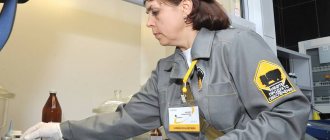What is a special assessment of working conditions
This is a set of measures, the purpose of which is to establish the presence of harmful factors in each workplace and assign it a risk class.
This is stated in Article 1 of the Federal Law of December 28, 2013 No. 426-FZ “On Special Assessment of Working Conditions” (hereinafter referred to as the Law on SOUT). There are four risk classes:
- Optimal (1.0): dangerous and (or) harmful production factors are either completely absent or are at a level that is safe for humans. The prerequisites have been created to maintain a high level of performance.
- Acceptable (2.0): there are dangerous and (or) harmful factors, but their impact does not exceed the levels established by hygiene standards. The altered functional state of the body is restored during rest, at the beginning of the next working day or shift.
- Harmful (3.0): levels of exposure to negative factors exceed the standard. It is divided into subclasses: first degree (3.1), second degree (3.2), third degree (3.3) and fourth degree (3.4).
- Dangerous (4.0): levels of exposure to negative production factors can create a threat to the life of an employee, and the consequences can lead to the development of an occupational disease.
The results of the SOUT are used, among other things, when assigning discounts and surcharges to the rate of contributions “for injuries” and additional tariffs for pension contributions. Employees who work in workplaces classified as hazardous (subclasses 3.2, 3.3 and 3.4) or hazardous classes are granted additional leave (Article 117 of the Labor Code of the Russian Federation). For classes 3.0 and 4.0, a salary increase of at least 4% of the salary or rate is provided (Article 147 of the Labor Code of the Russian Federation). There are other benefits as well.
Calculate “complex” salaries under different remuneration systems Try for free
Errors and violations made during the implementation of SOUT
Listed below are the most common mistakes made by employers and appraisers when conducting special assessments:
- Employer mistakes.
Due to the special assessment, the employer may be punished by labor inspectors. It's all about the numerous requirements that the law imposes on this procedure.
Let's name the most common violations of employers during the implementation of SOUT:
| Item no. | Type of violation | What legal norm has been violated? |
| 1 | The employer did not organize a planned special assessment | A special assessment is carried out at least once every 5 years, unless otherwise established by this law (clause 4 of article 8 of the Law of December 28, 2013 No. 426-FZ “On special assessment of working conditions”) |
| 2 | The employer did not organize an unscheduled special assessment | In a number of cases, the law obliges employers to carry out unscheduled SOUT (Article 17 of Law No. 426-FZ). For example, when changing the technological process, replacing production equipment, which can affect the level of exposure to harmful and (or) hazardous production factors on workers, etc. |
| 3 | SOUT was carried out by a company that does not have the appropriate accreditation (the special assessment report is invalid) | The requirements for such companies are specified in Art. 19 of Law No. 426-FZ. The list of companies authorized to carry out SOUT is posted on the website of the Ministry of Labor of the Russian Federation |
| 4 | The employer did not familiarize the employees with the results of the SOUT | The employer is given 30 calendar days from the date of approval of the SAW report to familiarize employees with the results of the assessment of their jobs. It does not include periods of temporary incapacity for work of the employee, being on vacation or a business trip, periods of rest between shifts (Clause 5 of Article 15 of Law No. 426-FZ) |
| 5 | The procedure for conducting a special assessment has not been followed (the results of the special assessment may be considered invalid) | The methodology for conducting a special assessment and the Classifier of harmful and (or) hazardous production factors, the form of the report on the implementation of the SOUT and instructions for filling it out were approved by Order of the Ministry of Labor of the Russian Federation dated January 24, 2014 No. 33n |
| 6 | Incorrect application of special assessment results | When providing compensation for work in harmful and (or) dangerous conditions, one cannot be guided solely by the results of a special assessment of workplaces. It is necessary to take into account the requirements of other legal acts of the Russian Federation (for example, the right to additional leave “for harmfulness” for medical workers of psychiatric medical institutions does not depend on the class of working conditions established based on the results of the special labor assessment, which is provided for other employees of medical organizations in accordance with paragraph 4, part 1 Article 22 of Law No. 3185-1) |
| 7 | The employer did not involve representatives of the trade union organization to participate in the special assessment procedure | If the company has a trade union or other representative body of workers, its representative must be included in the commission for conducting special labor assessment (part 2 of article 9 of Law No. 426-FZ) |
| 8 | The employer did not inform employees about the date of the special assessment, and they were unable to be present during it. | An employee has the right to be present during a special assessment at his workplace (Part 1, Article 5 of Law No. 426-FZ) |
| 9 | The employer did not take into account the suggestions of employees when identifying potentially harmful or dangerous production factors | The employee has the right to contact the employer, his representative, the organization conducting the special assessment, the expert of the organization conducting the special assessment with proposals for identifying potentially harmful and (or) dangerous production factors at his workplace and for obtaining clarification on the issues of conducting a special assessment of working conditions at work. his workplace (Article 5 of Law No. 426-FZ) |
| 10 | The special assessment commission did not identify all the harmful factors that affect employees | Identification of potentially harmful and (or) dangerous production factors in the workplace is carried out by an expert from the appraiser company. The results of identification of potentially harmful and (or) dangerous production factors are approved by the commission (Part 2 of Article 10 of Law No. 426-FZ) |
For an employer, a special assessment carried out with violations can result in a whole set of negative consequences - legal proceedings (if employees go to court to invalidate the results of the special assessment system), unscheduled visits by inspectors, examination of the special assessment system and other unexpected and not very pleasant events and unplanned expenses.
Let us note that the claims of workers and inspectors against the employer based on the results of special labor assessment, as judicial practice shows, are not always justified (see Decision of the Rebrikhinsky District Court of the Altai Territory dated January 14, 2019 in case No. 2A-14/2019, Appeal ruling of the Chelyabinsk Regional Court dated 04/16/2018 in case No. 11-5344/2018).
- Violations of the appraiser company.
It would be useful for the employer to become familiar with the mistakes that the appraiser company’s experts make in practice. Due to these errors, the results of the special assessment may be challenged and/or canceled:
Knowing about these shortcomings, the employer, when drawing up an agreement for the provision of services for carrying out special assessment and assessment work, can provide for separate conditions that will help avoid negative consequences due to errors made by the appraiser. In particular, it is possible to stipulate in the contract the procedure for the appraiser company to compensate the employer for losses incurred during a re-special assessment if the results of the special assessment are subsequently declared invalid due to violations committed by the appraiser company’s experts.
Who may not conduct an assessment of working conditions
SOUT is not mandatory for the following categories:
- organizations and individual entrepreneurs who have not concluded a single employment contract;
- employers - individuals without individual entrepreneur status;
- employers - religious organizations.
All employers, without exception, have the right to refuse SOUT in relation to the workplaces of homeworkers and remote workers (Part 3 of Art. Law on SOUT).
ATTENTION. Vacant positions are not subject to special assessment. The fact is that in the absence of employees, it is impossible to analyze their working conditions.
Who conducts a special assessment of working conditions
SOUT is carried out by a specialized third-party company with the participation of a commission created by the employer.
The commission includes: representatives of the employer and trade union organization (if it is created at the enterprise), an occupational safety specialist (see “How to become an occupational safety specialist”). It also needs to include the head of a small enterprise or individual entrepreneur. The head of the commission is appointed by the employer himself or his representative.
Compose HR documents using ready-made templates for free
The specialized third party company must meet the following criteria:
- SOUT is its main activity.
- The appropriate accreditation has been obtained.
- The staff includes at least 5 experts who have a certificate to perform special assessment work. At least one expert is a doctor in general hygiene (or occupational hygiene) or a doctor in sanitary-hygienic laboratory research.
- There is a testing laboratory accredited to measure harmful and dangerous factors in the production environment and the labor process.
How to conduct a special assessment of working conditions (SOUT)
To organize a special assessment of working conditions, an organization must take the following steps:

1 step. Select an organization that conducts SOUT
Such an organization must meet the following requirements:
- the Charter specifies the main type of activity as a special assessment of working conditions;
- The staff employs at least five experts who have certificates for performing special assessment work. One of them must be a doctor in general hygiene, occupational hygiene or sanitary-hygienic laboratory research;
- relevant organizations and experts must be included in a special register and have accreditation from the Ministry of Labor;
- the presence of a testing laboratory accredited to measure harmful and dangerous factors in the working environment.
Step 2. Conclude an agreement - cost of SOUT
When concluding an agreement (example of an SOUT agreement) with a selected specialized organization, it is necessary to separately stipulate the procedure for concluding an agreement, the cost of work and the timing of a special assessment. Usually, to conclude a contract, it is necessary to fill out an application on the basis of which it is concluded and submit a staffing table, on the basis of which the approximate price of the SOUT procedure is reported. To carry out the SOUT procedure itself, you will need many other documents that must be provided within the specified time frame. The list of documents is given below.
An approximate list of documents that may be required to conduct an SOUT:
- an order appointing a commission to conduct special assessment work (we will talk about this in paragraph 3)
- organization staffing table
- details of a legal entity
- statistics codes
- list of positions and professions subject to preliminary and periodic medical examinations (if any)
- results of previously conducted certification of workplaces for working conditions in the form of a summary table of classes of working conditions (if available)
- results of studies (tests) and measurements of harmful and (or) hazardous production factors previously conducted at these workplaces (if any).
- labor safety instructions
- information on accidents for the last 5 years (copy of act N-1 or copy of the accident log)
- list of positions in which work gives the right to early assignment of an old-age labor pension, a reduction in the length of the working week, and medical and preventive nutrition is provided (if available)
- list of personal protective equipment (if available).
- certificates for personal protective equipment for workers (if PPE is available).
- letter confirming the presence of employees under the age of 18 indicating their position
- information about production equipment, materials and raw materials, documentation for production equipment used at the workplaces of specific employees; technological documentation, technological process characteristics
- workplace layout diagram (you can use the Evacuation Plan or the Appendix to the premises rental agreement)
- information about SNILS of employees
- internal labor regulations (number of regulated breaks in work and their duration)
- a list of the organization's transport equipment indicating the number of drivers working in each vehicle, load capacity and type of fuel used, brand and year of manufacture
The timing of the assessment depends on the number of workplaces being assessed, the presence of similar places among them, the presence of hazardous working conditions and the territorial location of the organization. The special assessment procedure is carried out at the actual location of the company.
The cost of the SOUT will depend on the above factors. So, if you need to evaluate a “regular” workplace, then the cost can vary from 1200 to 1800, and for “harmful” workplaces the cost will be from 2500 rubles. “Additions” to the cost may also be charged for the urgency of the order. Below is a list of some organizations providing SOUT services, which we found in a search and called while preparing this material
Cost of SOUT as of February 1, 2021 table
| № | Name | City | Price per seat | Period of execution |
| 1 | Vocational Training Center | Smolensk | from 1200 rub. | 2 weeks |
| 2 | Hygiene Center | Smolensk | from 1500 rub. | 1 month |
| 3 | VVA Expert | Smolensk | from 1500 rub. | 3 weeks |
| 4 | EcoStandard group | Moscow | contract from 9,500 rub. | 2 weeks |
| 5 | PromMashTest | Moscow | contract from 10,000 rub. | 2 weeks |
| 6 | TechnoProgress | Moscow | contract from 25,000 rub. | 60 days |
After agreeing on all issues, you can sign the contract and make an advance payment for the special assessment.
Step 3. Create a commission to evaluate jobs
Members of the commission may be representatives of the employer (including a labor protection specialist) and a representative of the employees. The employer must head the commission. If employers - small businesses classified as micro-enterprises are unable to form a commission, the role of the commission is played by the employer - individual entrepreneur (personally), the head of the organization or another employee authorized by the employer. The composition and duties of the commission are established by order or regulation.
The responsibilities of the commission for conducting a special assessment of working conditions include:
- establishing a schedule for conducting a special assessment (the beginning and end of the special assessment procedure are formalized by orders);
- establishing a list of jobs to be assessed;
- determining the number of similar jobs;
- signing the report on the special assessment.
Important: not all similar jobs are assessed, but only 20% of such places from the total number, but not less than two, but the results of the inspection are applied to all similar jobs.
Thus, the organizational stage is completed. Next, a special assessment of working conditions is carried out by an expert from the selected specialized company. To do this, a certain series of actions are carried out, which are given below.
Step 4 Conduct a special assessment of working conditions
Includes the following stages (we won’t go into detail):
- study of workplaces to identify harmful factors, if any. If such factors are not found, then the second stage is skipped;
- measuring the level of harmful factors;
- distribution of jobs by classes of working conditions;
- registration of the results of a special assessment of working conditions.
Step 5 Results of the special assessment
If harmful factors are detected in the workplace, additional tests and measurements are carried out. Based on the measurement results, classes of working conditions are distributed:
- optimal,
- acceptable
- harmful
- dangerous.
Based on whether a workplace belongs to one of these classes, additional tariffs or discounts are calculated in the Pension Fund and the Social Insurance Fund.
Declaration of SOUT
Workplaces where no harmful factors have been detected are subject to declaration. The declaration of compliance of working conditions (with) state regulatory requirements for labor protection must be submitted to the labor inspectorate within 30 (thirty) days from the date of approval of the report of a special assessment of working conditions. In addition to the declaration, the employer provides the Labor Inspectorate with certified copies of the following documents:
- Title page of the approved SOUTH report;
- Expert opinion based on the results of the special assessment;
- Summary statement of the results of the SOUT.
SOUT report
Upon completion of the special assessment, a report on the special assessment of working conditions is drawn up ().
The SOUT report includes the following results of a special assessment of working conditions:
- information about the organization conducting a special assessment of working conditions, with copies of documents confirming its compliance with the requirements;
- a list of workplaces where a special assessment of working conditions was carried out, indicating harmful and (or) hazardous production factors that were identified at these workplaces;
- cards for special assessment of working conditions, containing information about the class (subclass) of working conditions at specific workplaces established by the expert of the organization conducting the special assessment of working conditions;
- protocols for conducting research (tests) and measuring identified harmful and (or) hazardous production factors;
- protocol for assessing the effectiveness of personal protective equipment used by employees employed in workplaces with hazardous working conditions, which have undergone mandatory certification in the manner established by the technical regulations, carried out in order to reduce the class (subclass) of working conditions (if such an assessment is carried out);
- protocol of the commission containing the decision on the impossibility of conducting research (tests) and measurements;
- summary sheet of special assessment of working conditions;
- a list of measures to improve the working conditions and safety of workers at whose workplaces a special assessment of working conditions was carried out;
- conclusions of an expert from an organization conducting a special assessment of working conditions.
The report is signed by all members of the commission and approved by the chairman of the commission no later than 30 (thirty) calendar days from the date of its sending to the employer by the organization conducting a special assessment of working conditions. Within 30 (thirty) days from the date of approval of the report, the employer must familiarize each employee with the report against signature. At the same time, summary data of the special assessment is posted on the official website of the organization. SOUT specialists, no later than 10 (ten) days from the date of approval of the report, data on the special assessment carried out are transferred to the Federal State Information System for recording the results of the special assessment of working conditions.
How to check SOUT by TIN
From 1.09.20, the results of the SOUT can be used only after the official publication of the report in the FSIS. Until this moment, working under a new conclusion is not allowed. Check the availability of SOUT by TIN.
Procedure for carrying out SOUT
Before starting the procedure, it is necessary to draw up a work schedule and a list of jobs that are subject to a special assessment. The form of these documents is free.
REFERENCE. SOUT is carried out in relation to the workplace, not the position. Therefore, if one person combines several positions at once, then you need to check how many jobs he actually occupies. And include each one in the list.
Further research is carried out within the framework of SOUT. Based on their results, a report is compiled. It is signed by specialists from an accredited third-party organization and members of the commission. At the same time, a card is filled out for each workplace (report forms and cards approved by order of the Ministry of Labor dated January 24, 2014 No. 33n). Employees should be familiarized with the card against signature within 30 calendar days from the date of approval of the report. Within the same period, summary data of the special assessment must be published on the employer’s official website (if available).
In addition, a declaration of compliance with working conditions is drawn up (the form and procedure for submission approved by order of the Ministry of Labor dated 02/07/14 No. 80n). It includes information about workplaces where harmful and dangerous production factors have not been identified, and working conditions are recognized as optimal and acceptable. The declaration must be submitted to the territorial labor inspectorate no later than 30 working days after approval of the report based on the results of the special labor inspection. The declaration can be submitted online on the Rostrud website. To do this, it must be signed with a qualified electronic signature.
Receive an enhanced qualified electronic signature certificate in an hour
Purpose of SOUT
Carrying out SOUT is the responsibility of the employer, established in Article 212 of the Labor Code. SOUT has been carried out since January 1, 2014, replacing workplace certification. The main purpose of the special assessment is to determine the class of working conditions.
Goals and objectives of the special assessment
To determine the class of working conditions, identification of harmful and hazardous production factors (HAPF) and laboratory studies of the levels of exposure to harmful substances are carried out in comparison with hygienic standards. Based on the results of the SOUT, the tariff for contributions to pension and social insurance is established.
Important! All guarantees and compensation established in the Labor Code and other by-laws can be established exclusively during a special assessment. The countdown from the date of accrual of guarantees and compensation begins from the moment the SOUT report is uploaded to the federal system. For secret institutions - from the date of approval of the report.
Information on the results of a special assessment of working conditions, including in relation to workplaces, the working conditions at which are declared as complying with state regulatory requirements for labor protection, are subject to transfer to the accounting information system, with the exception of information constituting a state or other secret protected by law, with taking into account the requirements of the legislation of the Russian Federation on personal data. The responsibility for transmitting the results of a special assessment of working conditions rests with the organization conducting the special assessment of working conditions .
The results of the conducted special assessment system are used to assess occupational risks , and they can also replace laboratory tests for industrial sanitary control. Therefore, this important event is separately highlighted in the code of administrative offenses, as well as in the rules for the reimbursement of funds for labor protection from contributions to compulsory social insurance.
Responsibility for violations in the conduct of SOUT
Violations during the SOUT procedure may entail punishment for both the employer and the expert and expert organization.
In the Code of Administrative Offenses, the employer's responsibility is specified in Part 2 of Article 5.27.1.

If the SOUT is not carried out on time, a mistake is made when creating the commission, or the employees are not familiarized with the results of the special assessment, the legal entity will be fined in the amount of 60 to 80 thousand rubles . If an individual entrepreneur commits the same violations, the fine may range from 5 to 10 thousand rubles. But that's not all.
Officials may also bear personal liability from 5 to 10 thousand rubles. Such officials include members of the commission, a labor protection specialist, as well as other authorized persons who are brought to administrative responsibility by decision of the State Labor Inspectorate or the court. But not only the employer is responsible for the quality of the SOUT.
The Code of Administrative Offenses has article 14.54. It states that if an expert organization violates Law No. 426-FZ, the SOUT expert will be fined in the amount of 25 to 30 thousand rubles. In this case, the expert organization itself may be fined from 70 to 100 thousand rubles.
If this is not the first time that an SOUT expert has been “caught”, and has previously been fined under the same article, he can be fined 40-50 thousand rubles, but the worst thing is that the expert can be disqualified for 1 to 3 years, by a court decision. In this case, the expert organization will be fined up to two hundred thousand rubles, or its activities will be suspended for three months. This is a long period of time during which an accredited organization can lose clients, and the disqualification of an expert means that he will not be able to work in his specialty.
Timing and frequency of carrying out SOUT
The last stage of the special assessment was completed by January 1, 2019 (Part 6 of Art. Law on SOUT). It is assumed that by this date all employers have carried out the above activities and submitted the declaration on time.
When should the next SOUT procedure be scheduled? If there are no industrial accidents or occupational diseases, and inspectors do not find violations in the field of labor protection, there is no need to do a second special assessment. And only upon the occurrence of one of these events, it is necessary to carry out an unscheduled assessment of labor conditions and re-submit the declaration (see “The declaration of special assessment of working conditions was made indefinite”).
IMPORTANT. When a new workplace appears, it is necessary to organize an unscheduled special assessment. This must be done within 12 months from the date it was put into operation.
The cost of the special assessment and who pays for it
The law does not regulate the cost of the procedure. The price depends on a number of factors: market conditions, size of the organization, number of staff, etc. On average, SOUT for one place costs from 600 rubles. Most accredited companies have set a lower price threshold: even if a special assessment needs to be carried out for a small number of jobs, for example, one or two, you will have to pay at least 10,000 rubles for the procedure.
As a general rule, the employer must finance the entire range of measures for a special assessment of working conditions. But he can reimburse a certain amount through contributions for insurance against industrial accidents and occupational diseases. It is permissible to direct part of such contributions to the prevention of injuries and occupational diseases, including to the SOUT (see “The procedure for reimbursement of expenses for the reduction of injuries and occupational diseases has been changed”).






